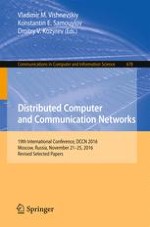This book constitutes the refereed proceedings of the 19th International Conference on Distributed and Computer and Communication Networks, DCCN 2016, held in Moscow, Russia, in November 2016.
The 50 revised full papers and the 6 revised short papers presented were carefully reviewed and selected from 141 submissions. The papers cover the following topics: computer and communication networks architecture optimization; control in computer and communication networks; performance and QoS/QoE evaluation in wireless networks; analytical modeling and simulation of next-generation communications systems; queuing theory and reliability theory applications in computer networks; wireless 4G/5G networks, cm- and mm-wave radio technologies; RFID technology and its application in intellectual transportation networks; internet of things, wearables, and applications of distributed information systems; probabilistic and statistical models in information systems; mathematical modeling of high-tech systems; mathematical modeling and control problems; distributed and cloud computing systems, big data analytics.
